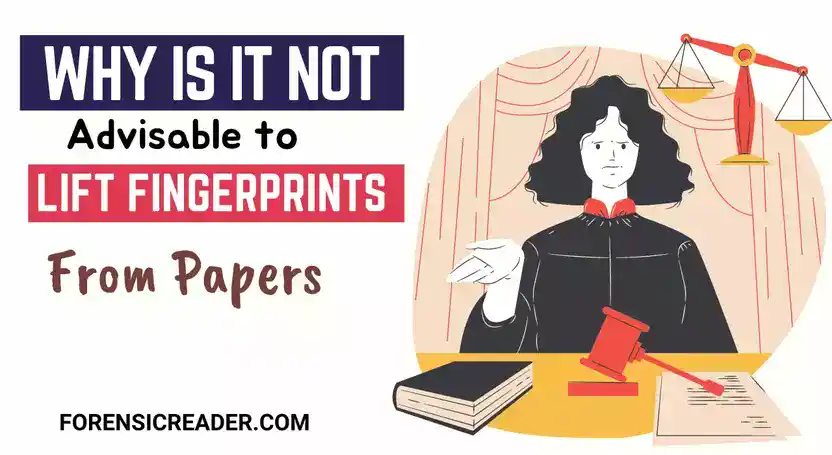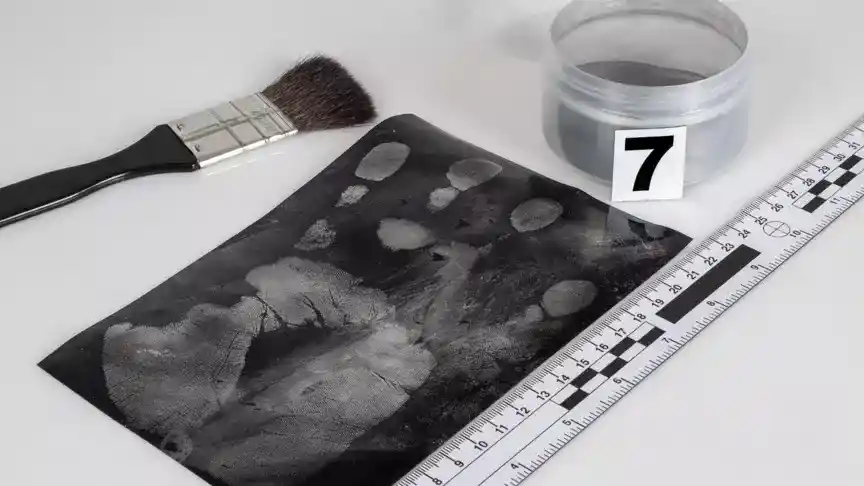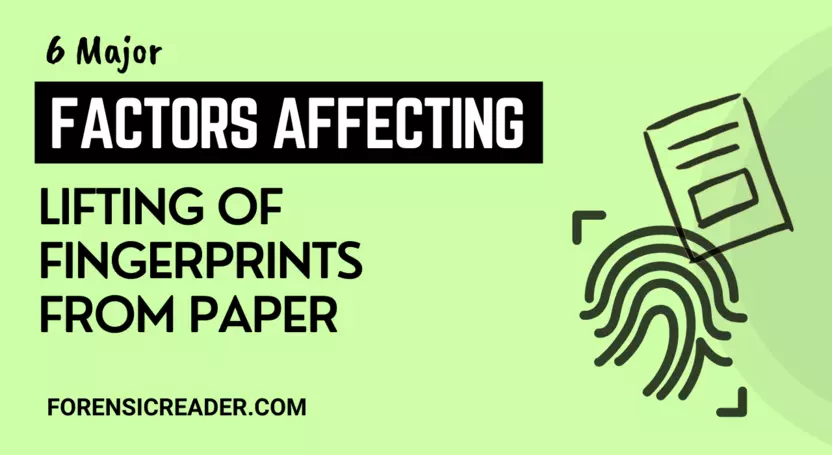Lifting fingermarks is never easy. Based on the surface on which the fingermark rests, the examiner decides whether lifting would be needed or not. This is also true for papered documents.
Normally, latent fingerprints are not required to lift because the prints are soaked in and no longer on the paper surface. Thus, they are documented using photography or high dpi scanners.
So, with this post, I try to answer the most common ways of lifting fingerprints from paper. Plus, try to answer the possibility of lifting them.
Can Fingerprints be Lifted from Paper?
Practically, Yes. You first have to develop fingermarks using a powder method (chemical means not recommended) and lift them using lifting measures. And the quality of lifted prints depends on the surface of the paper.
If a paper is glossy, lifted prints are crisper and fiber-free. However, if the paper has a rough surface, traces of fibers sit with or around the lifted fingermarks.
That’s the reason why forensic document examiners prefer to develop the print and document them with high-resolution photography. Let’s cover this topic in detail.
Why is it Not Advisable to Lift Fingerprints from Paper?

Following are the reason why forensic examiners try not to lift finger marks from papered questioned documents:
Reason 1: Because of its Surface
The surface of paper can be porous or semi-porous. That makes it a good absorbent. So, when fingers are pressed over a paper, the liquid residue of finger marks such as fats, lipids, etc. begins to get soaked in it.
As time passes, these prints become so soaked that they nearly have any sticking ability which can be used by powder method to adhere to their surfaces. This makes lifting harder from powder methods.
Here, chemical methods come in handy with a key disadvantage. The chemical methods don’t adhere to prints like powder, but chemically paint (react) them, and soaked too in the paper.
That gives a key advantage of developing old prints, and at the same time hinders the lifting ability. So, the examiner documents them using photography.
I am not saying you can’t lift chemically developed finger marks. They are, however, not as sharp and contrasting as the powder ones.
Reason 2: Second Opinion or Re-examination
In many instances, it is recommended to prefer forensic document examination over fingerprint development. Thus, before developing fingermarks, FDEs would have prepared their reports.
Know more: Which One should be Preferred: Fingerprint or Questioned Documents?
But in case, a second opinion or re-examination is needed, the lifting finger marking may hinder the successive analysis. This is often seen in the case of prints over watermarks. Lifting them majorly captivates the pulp fiber analysis of paper (detailed article).
How do you Lift Latent Fingerprints from Paper?

Following is the step-by-step guide on what you need and how you can develop and lift the fingerprints from papered questioned documents.
What do you need?
- Rubber or cotton thick gloves
- Fine-tipped permanent marker
- Fingerprint brush
- Appropriate powder method
- Roll of 2”, 3”, or 4” latent lifting tape, and of course
- Questioned document
Step 1: Identifying Prints (Visual Inspection)
1. A pre-visual inspection should be done to identify the possible region of finding latent prints. The most common equipment needed is Video Spectral Comparator (VSC) or an alternative light source.
2. If a fingerprint is visible, it should be documented with photography.
Step 2: Developing Prints on Paper
3. Using an appropriate contrasting shade of powder, the finger marks are brushed gently.
Know More: Destructive and Nondestructive Techniques of Developing Fingerprint on Paper
4. Now, remove the excess powder over the prints by dusting and twirling with gentle strokes. The resultant fingerprints should be clear and crisp.
5. Before you stick the lifting tape over the developed prints, first photograph them under oblique lighting.
Step 3: Lifting of Fingerprints
6. Peel a length and unroll them in one continuous motion. Pulling in stages causes hesitation marks (lines where the tape is stopped and then pulled).
7. Apply a suitable length of tape over the developed prints so that it covers the whole area.
8. Before lifting back, check for air bubbles and, if any, remove them by pressing with your thumb or by a stationary erasure.
9. Carefully lift the developed print and place it on the white side of a latent lift card and avoid bubbles.
10. Fill the face card (where prints go to sets) with appropriate case information including:
- Case/report number
- Date/time
- Scene Address
- Person who lifts fingerprints
- Object lifted from
- Location of print on the object (sketch if possible)
11. Again photograph the lifted printed with all necessary case information.
12. If necessary, the finger marks can be reprocessed and lifted again.
Please Note: In case of more than one finger or palm, or their combination appears, use wide tape lifters and consider them a single unit.
Lifting Prints from Glossy Questioned Documents
You just have to first identify the prints, develop them, photograph them, fill in the necessary case information, lift them, paste them over the white/black side of the card, and lastly, photograph them.
All processes are the same. But a fingerprint examiner might face a big challenge while dealing with glossy paper.
As air bubbles are common while taping them over the surface. But they are too intrusive in glossy papers.
This is because of the electrical repulsion of a similar static charge. This later may cause:
- Loosely adhesion of charged powder to tape,
- Acts as a barrier between the tape and glossy paper surface, causing a slight sliding effect that results in smudged print.
They are not common but more prevalent during low humidity conditions.
Factors Affecting Lifting Fingerprints from Paper

Majorly, if you have a questioned document and want to lift fingerprints, these are some factors that affect the lifting of prints from a paper.
1. Surface Textures
The surface texture of the paper is also called a tooth. It defines how the surface feels on paper. More the tooth, rougher the surface. This means more possibility of getting fibers and other debris during the lifting of prints.
2. Surface Finishes
During the manufacturing process, a different type of coating or additives is added to the paper that alters the surface finishes. Following are some of these.
| Paper Type | Surface Feature | Print Develop | Lifting Recs. |
|---|---|---|---|
| Smooth | Smooth | powder, chemical | No for chemical |
| Vellen | Semi-smooth | powder, chemical | No for chemical |
| Glossy | Very smooth | powder | Yes |
| Parchment | Slightly rough | chemical | No |
| Cockle | Uneven wrinkle surface | chemical | No |
| Embossed | Raised detailing | chemical | No |
| Pinstripe | ribbed texture over the surface | chemical | No |
| Foil | Thin-film of shiny metal | powder | Yes |
3. How long Fingermarks Stayed
The longer the marks stay on paper, the higher paper absorbs its constituents. Thus, with time, the chances of developing and lifting using the powder method diminishes.
Fresh marks can easily be dusted and lifted, eg. suspect prints for comparison. On the other hand, old prints lose their stickiness which leads to chemical means of development.
4. Development Techniques
There are two developing methods: chemical and powder. Chemical works better on porous surfaces while powder works better on fresh and non-porous surfaces.
However, if the prints are recently registered even on a porous surface like paper, they can be easily developed. Over time, they lost stickiness and needed to develop using chemical methods.
Methods like ninhydrin, iodine fuming and DFO are proven to work best on porous or semi-porous surfaces such as paper, cardboard, magazine covers, and so on.
But, this makes it difficult to lift prints from questioned documents.
New Development: Nanopowders have a diameter of 1- 100 nm which gives a far surface area to volume ratio that can reveal the finest ridge details by adhering more readily and possibly develop fine detailing in case of old fingerprints on paper.
5. Debris on Fingermarks
Some debris such as dust, hair, or other non-sticky debris can easily be cleaned using gentle strokes of the brush. And making it debris-free, prints can be developed and lifted easily.
However, debris such as grease, biological fluids, or other sticky ones, are not to be cleaned, and not recommended to do so. In that case, print is usually visible and doesn’t need development, or they cover (fully or partially) the fingermarks.
So, if you try to lift them, it may cause more smudginess of fingerprints.
6. Watermarks or Ribbed Papers
Fingerprints on partially translucent paper-like watermarks or ribbed papers need extra caution.
This is because, if the fingermarks on the watermark or ribbed area of the paper, share two different surface textures;
- Watermark area: translucent, smooth, and less absorbent
- Rest of paper: opaque, slightly rough, more absorbent
This causes a different absorption rate, making some ridges too soaked while others are less soaked.
Developing these prints using powder methods results in partially contrasting prints that can be easily eliminated using chemical methods. Moreover, lifting them may hinder the further analysis of watermarks, if needed.
Know More: Forensic Examination of Genuine Watermarks on Questioned Documents
Fingerprint Lifter for Questioned Documents
Following are some of the common types of fingerprint lifters that are used to lift fingerprints on paper.
- Transparent tape lifters: has a continuous adhesive film
- Hinge lifters: Has an adhesive side (for lifting) hinged with a backing card (lifted mark folded too) from one side.
- Rubber-gelatin lifters: composed of adhesive gelatin layer, elastic rubber sheet, and cover sheet. Not mainly used for paper.
- Lifting sheets: Different sizes and not used for lifting prints from paper.
Can Someone Lift (copy) and Place the Fingerprint on a Paper Questioned Document?
Yes, it is possible. How?
After lifting the prints, the prints are placed over the other sheet by sticking the top side first to the surface with a slight force leaning downwards.
Allow the prints to soak into the paper before removing the tape, leaving the contrast print behind.
Latent prints (without development) can, however, be lifted if they are not soaked in the paper, such as on glossy sheets, and easily transferred to new sheets without the need for development.
But it can be identifiable. Let’s check it out!!!
How to Identify Whether Fingerprint is Lifted from a Paper or not?
The prints on paper are mostly latent (not visible) and needed to develop before being lifted. The resulting finger marks are visible— that’s odd.
Microscopic examination can reveal the powder particle overprints.
Plus, the lifting fingerprint from one paper leads to lifting fibers and also causes fiber disturbance. Similarly, fiber disturbance can be seen around the transferred finger marks.
These disturbed, worn-off and misaligned fibers around the fingermarks areas can be revealed with fiber microscopic analysis using a scanning electron microscope.
However, the extent of fiber lift-off depends on the paper surfaces. Lifting captures very few to no fibers if it is glossy. In these cases, even fresh latent prints can be easily identified and transferred to other glossy paper.
General FAQ
Why is it difficult to lift fingerprints from paper?
Because paper has porous surfaces that absorb most of the sticking ability of prints, minimizing the possibility of getting developed using powder methods. So, chemical measures are needed, that develop prints but get soaked in the paper, making it difficult to lift fingerprints.
Can regular tape be used for lifting fingermarks?
Practically, the regular tape can lift fingermarks, but forensically, not applicable. Because it has higher adhesion (causes fiber disruption), thinness, and flexibility. Plus, adhesion layers sometimes leave the plastic film and get stuck over the lateral surface, making them stick and potentially destroying fingermarks.
Which type of development techniques aids fingerprint lifting from paper?
Powder methods are the easiest and develop a good range of prints. Most commonly black or white shades of powder are used. For multi-colored paper such as magazines, fluorescent powder is used.
Is it legal to lift a fingerprint and place it over another questioned document?
It can’t be legal. Intentionally, lifting and placing them over other surfaces is a fabrication. You may face a charge for tampering with evidence and even lend you to legal punishment. You can find out more by checking the link on legality in question documents.
What common caution should be followed during lifting fingerprints?
The lifting tape should be smooth, thick, and less flexible. Try to open a continuous film without and break and lift prints without any air bubbles. Before lifting, one should take a photograph. If more than one print, treat them as one unit.
Continue Reading:
- Legal Obligation of Person’s Fingerprints Over Questioned Documents
- 14 Myths of Fingerprints And Questioned Documents: A Forensic Study
- Is it possible to remove a fingerprint from paper?
- How Long Fingerprints Last on Paper?
- 21+ Forensic Questioned Document Instruments And Tools With Uses

FR Author Group at ForensicReader is a team of Forensic experts and scholars having B.Sc, M.Sc, or Doctorate( Ph.D.) degrees in Forensic Science. We published on topics on fingerprints, questioned documents, forensic medicine, toxicology, physical evidence, and related case studies. Know More.
